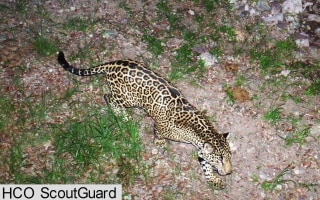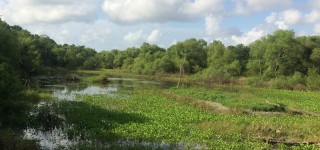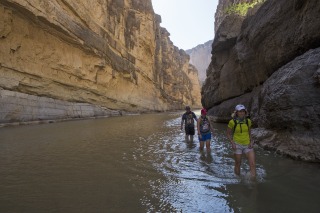begin quote from:
BROWNSVILLE,
Texas — The promise of a "big, beautiful wall" along America's southern
border was a cornerstone of President Donald Trump's campaign. From the
moment he announced it during his candidacy kickoff address in …
Trump’s Border Wall ‘Catastrophic’ for Environment, Endangered Species: Activists
BROWNSVILLE, Texas — The promise of a "big,
beautiful wall" along America's southern border was a cornerstone of
President Donald Trump's campaign. From the moment he announced it
during his candidacy kickoff address in June 2015, the proposal was hit
with charges of racism and questions of effectiveness.
But during almost two years of heated debate over the wall, there has been an often overlooked issue — the potentially "catastrophic" environmental toll the wall could have on the hundreds of species that span the frontier, activists say.
"This would cause incalculable damage to the integrity of wildlife populations on either side of the border, as well as the massive societal disruption it would cause," Defenders of Wildlife's Senior Vice President of Conservation Programs Bob Dreher told NBC News.
But during almost two years of heated debate over the wall, there has been an often overlooked issue — the potentially "catastrophic" environmental toll the wall could have on the hundreds of species that span the frontier, activists say.
"This would cause incalculable damage to the integrity of wildlife populations on either side of the border, as well as the massive societal disruption it would cause," Defenders of Wildlife's Senior Vice President of Conservation Programs Bob Dreher told NBC News.
Scientists and conservationists said such drastic increases in border security could be devastating for hundreds of species, and potentially lead to extinction in the U.S. for endangered or threatened animals like jaguars, ocelots, and the Mexican gray wolf.
They say construction of an impenetrable divider could destroy or damage natural habitats, cut off animal populations who depend on the ability to roam at the border, prevent genetic diversity that's important to sustaining animal populations and lead to a loss of natural resources.
More than 100 animals that are listed as threatened, endangered or candidates for such status under the Endangered Species Act from coast to coast could potentially be impacted by Trump's proposal, according to a 2016 analysis of data from the U.S. Fish and Wildlife Service.
"It will choke off life from both sides," wildlife biologist Jeff Corwin told NBC News.
Corwin said that many species of animals and birds rely on the ability to traverse the border for everything from seasonal access to natural resources, nesting and reproduction sites to maintaining genetically diverse populations.
Last week, an environmental group and an Arizona Congressman filed what they say is the first federal lawsuit against Trump's border wall plan, calling on the administration to assess the proposal's environmental impact.
"It's been more than 15 years since the government has done any complete analysis of its border security policy," Randy Serraglio, a Southwest conservation advocate with the Center for Biological Diversity, which filed the suit, told NBC News. "So, it's long overdue."

Under NEPA, which was signed by President Richard Nixon in 1970, federal agencies must conduct an environmental review of major actions where there could be significant effects.
The lawsuit argues that it's time for DHS to provide a supplemental environmental impact statement to the one conducted back in 2001.
"What really compels the timing now, of course, is that we have a proposal on the table to dramatically ramp up border security activities," Serraglio said.
Gillian Christensen, the acting press secretary for DHS, said as a matter of policy the agency does not comment on pending litigation.
Grijalva, who said that 300 miles of his district runs along the border, added that it was "time to bring some accountability" to the administration.
"We need an environmental impact assessment and analysis as to what the intended and unintended consequences are going to be," he said.
But the legal situation is complicated because of REAL ID, an act signed by President George W. Bush in 2005, which gives DHS authority to waive most environmental assessments — as well as many federal, state and local laws — in the name of national security.
Experts said REAL ID has kept scientists in the dark about the effects the fences and walls currently covering over 650-miles of the border have already had on the environment.
"There's a big gap in our knowledge here scientifically in terms of what actual impacts could be or will be," said Jesse Lasky, a biologist and professor at Penn State University who has conducted one of the few studies examining the effect of existing barriers on wildlife along the border.
"We would have a much clearer picture of it if some of the typical studies were done following the initial construction," he said.
Lasky's study, which was published in 2011, examined the impact of current and future barriers along the border for the range of 313 mammals, amphibians and reptiles. Among the species most at risk were four listed as threatened globally or by both border nations, plus an additional 50 species.
The study identified three regions that were most vulnerable — the two coastal regions along California and Texas as well as the Madrean Sky Island Archipelago, which is along the border in New Mexico and Arizona.
New barriers would increase the number of species already at risk, especially in those three regions, the study found, and Lasky said the effects could be much greater under Trump's proposal.
"I mean what they've proposed is many times worse than what we've done," he said, adding, "That kind of wall would stop any movement of anything that couldn't fly above the wall and that would be hundreds of species of animals."
The biggest threat to some larger animals along the border — including jaguars, ocelots, mountain lions, bears and wolves — was habitat "fragmentation," Howard Quigley, Jaguar Program Executive Director and Puma Program Director for Panthera, the global wild cat conservation organization, said.

If you step beyond the fence erected north of the Rio Grande that serves as the border between Texas and Mexico, you'll find a nature preserve that preceded the fence and has been maintained, and resuscitated, to conserve the last of the state's remaining natural growing Sabal Palm and all the wildlife that surrounds it.
"It would be catastrophic for the environment, because for the first time in the geological history of this natural corridor, which affects North to South America, there would be a barrier like that," Corwin said.
Sprawling for nearly 2,000 miles from Texas all the way to California, conservationists say the border is home to valuable wildlife refuges, national parks, public lands and important biodiversity.
In Texas, where the Rio Grande Valley is dotted with areas that often go overlooked in the national discussions of life on the border, one of the poorest areas in the country has tried to preserve and promote its natural resources for ecological and economic purposes.
Yet once again, there is worry and uncertainty about what blow their conservation efforts will take as Trump moves forward in building the wall.
"I think there's some trepidation and fear — what does building a wall through that habitat do? How much of it gets destroyed? How does it affect what people have spent decades trying to preserve and keep in its native habitat?" said former Brownsville Mayor Ygnacio Garza.
Alejandro Fierro Cabo, an assistant professor at the School of Earth, Environmental and Earth Sciences at the University of Texas Rio Grande Valley, told NBC News the wall wouldn't just hurt animals, but plant populations critical to the area.

O'Mara said the NWF found that Trump's proposal would affect as much as 75 percent of the valley's national wildlife refuge complex.
A 34-mile area in the Rio Grande Valley of south Texas is the administration's highest priority for a border wall, according to a draft of a report to the White House.
Already, some private land owners further west on the Rio Grande have received condemnation notices from the government notifying them they plan to build the border wall on their property.
O'Mara said he expected there would "a series of challenges" to Trump's border proposals, both for its potential toll on wildlife and human beings.

Lasky said the new lawsuit stands as long as the Trump administration hasn't filled out any waivers regarding environmental laws.
"But it seems that as soon as they want to file those waivers, I don't see the suit has much more power," he said.
Dreher on the other hand, was more hopeful.
Back in 2008, Defenders and the Sierra Club turned to the Supreme Court after then-DHS Secretary Michael Chertoff waived 19 laws in order to speed up construction of over 300 miles of border.
Defenders argued that the secretary's power was unconstitutional. The Supreme Court declined to hear their case, but Dreher said he hoped someone would once again take the mantle should the DHS pursue those waivers.
"It's still ripe and if there are new waivers issued by the secretary of Homeland Security, my hope is that someone will lead that challenge up to the Supreme Court and that we will get a ruling on this sweeping waiver authority," he said.

But Corwin said his environmental concerns with Trump's administration went beyond the proposed border wall.
"What I have come to believe is that the Trump administration is crafting the perfect extinction storm," Corwin said.
The wildlife biologist cited the president's appointment of climate change skeptic Scott Pruitt to head the EPA and his proposal to slash funding for governmental institutions "responsible for national environmental stewardship" and resource management — such as the EPA, the Department of the Interior and NOAA.
"I have seen nothing that gives me any comfort that this administration has remotely entertained the level of the conservation challenges that it faces," he said.
Corwin argued that the country's rich landscape, natural resources and biodiversity were part of "what makes America great."
"Isn't that part of what we have that no one else has?" he said. "I don't want to lose that."
Suzanne Gamboa reported from Brownsville, Te

No comments:
Post a Comment